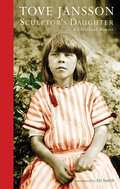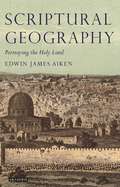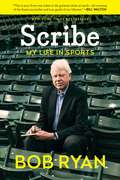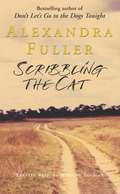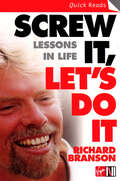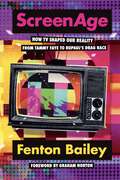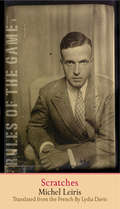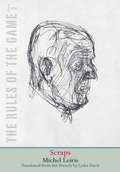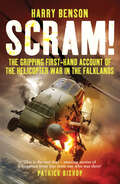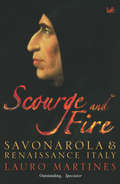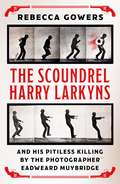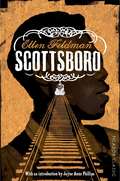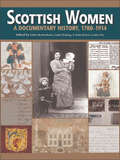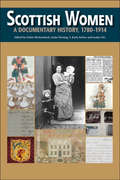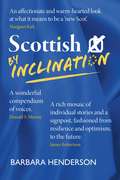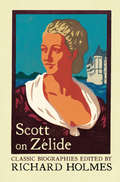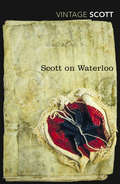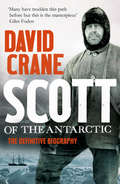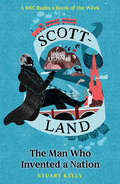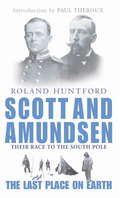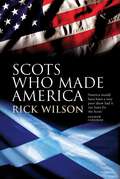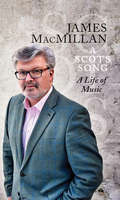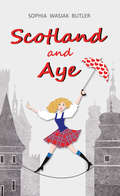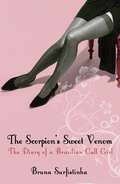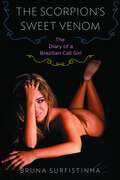- Table View
- List View
Sculptor's Daughter: A Childhood Memoir
by Tove JanssonTove Jansson's first book for adults was a memoir, capturing afresh the enchantments and fears of her Helsinki childhood. Presented with images from her family archive, Sculptor's Daughter gives us a glimpse of the mysteries of winter ice, the bonhomie of balalaika parties, and the vastness of Christmas viewed from beneath the tree. Tove Jansson (1914-2001) is best known as the creator of the much loved Moomin stories for children. However, in her fifties she turned her attention to writing for adults, producing a dozen novels and story collections. Sculptor's Daughter (translated by Kingsley Hart) was the first, published in 1968.
Scriptural Geography: Portraying the Holy Land (Tauris Historical Geographical Series)
by Edwin James AikenIt is easy to find Palestine... But how to find the Holy Land -- ah, that is another matter' (Out-of Doors in the Holy Land, 1908)Geographies of the Holy Land are almost as old as Christianity itself. In the ancient world works such as the Onomasticon of Eusebius were intended primarily as aids to biblical understanding but by the early nineteenth century books about the Holy Land had become entangled in concerns over the relationship between the scriptural and scientific uses of this sacred landscape. The Holy Land was not just a physical region on the surface of the Earth - it was an idea, an intellectual and moral space charged with the heat of religious debate and with the noisy engagements of those trying to understand the religious, social and scientific upheavals of the time. EdwinJames Aiken explores the various ways in which geographical knowledge was used in the management of this celestial landscape and the production of its geography. In particular he shows how religious writers called upon geographical knowledge in different ways at different times to the benefit of their readers. He pays particular attention to the political, social and religious currents at play and to the dissonance between religion, theology and science. The result is an original and stimulating work of scholarship that demonstrates the significance of the geography of the Holy Land in Western thought and argument and makes important contributions to the history of geography, the nature of Orientalism, and to the evolving relationship between religion and science.
Scribe: My Life in Sports
by Bob RyanEver since he joined the sports department of the Boston Globe in 1968, sports enthusiasts have been blessed with the writing and reporting of Bob Ryan. Tony Kornheiser calls him the "quintessential American sportswriter.†? For the past twenty-five years, he has also been a regular on various ESPN shows, especially The Sports Reporters, spreading his knowledge and enthusiasm for sports of all kinds. Born in 1946 in Trenton, New Jersey, Ryan cut his teeth going with his father to the Polo Grounds and Connie Mack Stadium, and to college basketball games at the Palestra in Philadelphia when it was the epicenter of the college game. As a young man, he became sports editor of his high school paper-and at age twenty-three, a year into his Boston Globe experience, he was handed the Boston Celtics beat as the Bill Russell era ended and the Dave Cowens one began. His all-star career was launched. Ever since, his insight as a reporter and skills as a writer have been matched by an ability to connect with people-players, management, the reading public-probably because, at heart, he has always been as much a fan as a reporter. More than anything, Scribe reveals the people behind the stories, as only Bob Ryan can, from the NBA to eleven Olympics to his surprising favorite sport to cover-golf-and much more It is sure to be one of the most talked-about sports books of 2014, by one of the sports world's most admired journalists.
Scribbling the Cat: Travels with an African Soldier
by Alexandra FullerWhen Alexandra "Bo" Fuller was in Zambia a few years ago visiting her parents, she asked her father about a nearby banana farmer who was known for being a "tough bugger". Her father's response was a warning to steer clear of him: "Curiosity scribbled the cat," he told Bo. Nonetheless, Fuller began her strange friendship with the man she calls K, a white African and veteran of the Rhodesian War. With the same fiercely beautiul prose that won her such acclaim for Don't Let's Go to the Dogs Tonight, Fuller here recounts her friendship with K. He is, seemingly, a man of contradictions. Tattooed, battle-scarred, and weathered by farm work, K is a lion of a man, feral and bulletproof. Yet he is also a born-again Christian, given to weeping when he recollects his failed romantic life and welling up inside with memories of battle. For his war, like all wars, was a brutal one, marked by racial strife, jungle battles, brutal tortures, and the murdering of innocent civilians. Like all the veterans of the war, K has blood on his hands. Driven by K's memories, Fuller and K decide to enter the heart of darkness in the most literal way, by traveling from Zambia through Zimbabwe (formerly Rhodesia) and Mozambique to visit the scenes of the war and to meet other veterans. What results from Fuller's journey is a remarkably unbiased and unsentimental glimpse at life in Africa, a land that besets its creatures with pests, plagues, and natural disasters, making the people there at once more hardened and more vulnerable than elsewhere.
Screw It, Let's Do It: Lessons In Life
by Sir Richard BransonThroughout my life I have achieved many remarkable things. In Screw It, Let's Do It, I will share with you my ideas and the secrets of my success, but not simply because I hope they'll help you achieve your individual goals. Today we are increasingly aware of the effects of our actions on the environment, and I strongly believe that we each have a responsibility, as individuals and organisations, to do no harm. I will draw on Gaia Capitalism to explain why we need to take stock of how we may be damaging the environment, and why it is up to big companies like Virgin to lead the way in a more holistic approach to business. In Screw It, Let's Do It I'll be looking forwards to the future. A lot has changed since I founded Virgin in 1968, and I'll explain how I intend to take my business and my ideas to the next level and the new and exciting areas - such as launching Virgin Fuels - into which Virgin is currently moving. But I have also brought together all the important lessons, good advice and inspirational adages that have helped me along the road to success. Ironically, I have never been one to do things by the book, but I have been inspired and influenced by many remarkable people. I hope that you too might find a little inspiration between these pages.
ScreenAge: How TV shaped our reality, from Tammy Faye to RuPaul’s Drag Race
by Fenton Bailey'Like a superheated kernel of corn, the world has gone Pop... Drag has become mainstream. Being gay became cool. From being the criminal outsider, being queer has even become representative of the way the outsider voice is common to us all.'When he moved to New York in 1982, Fenton Bailey saw the world go Pop. Together with filmmaking partner Randy Barbato, their production company World of Wonder would pioneer the genre of Reality TV and chronicle the emerging Screen Age through their extraordinary programs and outrageous subjects - from Bible Belt televangelists and conspiracy theories to pioneering drag queens.Working with icons such as Britney Spears, Tammy Faye Bakker and RuPaul, the production company's shows tell a wider story of how television has fundamentally shifted our reality.Packed with glorious insider gossip and amazing celebrity stories, these are the riotous tales behind the shows that would make ScreenAgers of us all.
Scratches: The Rules of the Game, Volume 1 (The Margellos World Republic of Letters)
by Michel LeirisA dazzling translation by Lydia Davis of the first volume of Michel Leiris’s masterwork, perhaps the most important French autobiographical enterprise of the twentieth century Michel Leiris, a French intellectual whose literary works inspired high praise from the likes of Simone de Beauvoir and Claude Lévi-Strauss, began the first volume of his autobiographical project at the age of 40. It was the beginning of an endeavor that ultimately required 35 years and three additional volumes. In Volume 1, Scratches, Leiris proposes to discover a savoir vivre, a mode of living that would have a place for both his poetics and his personal morality. “I can scarcely see the literary use of speech as anything but a means of sharpening one’s consciousness in order to be more—and in a better way—alive," he declares. He begins the project of uncovering memories, returning to moments and images of childhood—his father’s recording machine, the letters of the alphabet coming to life—and then of his later life—Paris under the Occupation, a journey to Africa, and a troubling fear of death.
Scraps: The Rules of the Game, Volume 2 (The Margellos World Republic of Letters #2)
by Michel LeirisThe second volume of Michel Leiris’s hugely influential four-volume autobiographical essay, available to English-language readers in a brilliant and sensitive translation by Lydia Davis One of the most versatile and beloved French intellectuals of the twentieth century, Michel Leiris reconceives the autobiography as a literary experiment that sheds light on the mechanisms of memory and on the way the unconnected events of a life become connected through invented narrative. In this volume, the second in his four-volume epic autobiographical enterprise, Leiris merges quotidian events with profound philosophical self-exploration. He also wrangles with the disillusionment that accompanies his own self-reflection. In the midst of struggling with his own motives for writing an autobiographical essay, he comes to the revelation that life, after all, has aspects worth remembering even if moments of beauty are bookended by misery. Yet what can be said of human life, of his own life, when his memory is unreliable, his eyesight is failing, and his mood is despairing?
Scram!: The Gripping First-hand Account of the Helicopter War in the Falklands
by Harry BensonIn April 1982 Harry Benson was a 21-year-old Royal Navy commando helicopter pilot, fresh out of training and one of the youngest helicopter pilots to serve in the Falklands War. These pilots, nicknamed 'junglies', flew most of the land-based missions in the Falklands in their Sea King and Wessex helicopters. Much of what happened in the war - the politics, task force ships, Sea Harriers, landings, Paras and Marines - is well-known and documented. But almost nothing is known of the young commando helicopter pilots and aircrewmen who made it all happen on land and sea. This is their 'Boys Own' story, told for the very first time. Harry Benson has interviewed forty of his former colleagues for the book creating a tale of skill, initiative, resourcefulness, humour, luck, and adventure. This is a fast-paced, meticulously researched and compelling account written by someone who was there, in the cockpit of a Wessex helicopter. If you liked Apache, Vulcan 607 and Chickenhawk, you'll love Scram! The word "Scram" was used to warn other junglies to go to ground or risk being shot down by their own side as Argentinean jets blasted through 'bomb alley'.
Scourge and Fire: Savonarola and Renaissance Italy
by Lauro MartinesWhen the King of France invaded Italy in 1494, princely states would fall, sending tremors up and down the peninsula. The Medici fled from Florence; the republic sprang back to life; and the French army, occupying the Renaissance city for ten terrifying days, stood on the verge of sacking it. A 'little friar' from Ferrara, Savonarola was alone in knowing how to comfort citizens with his sermons and in urging the King to get out of Florence.Although the French left a city riven by political factions, the Friar's popular 'party' swiftly prevailed. With Florence at the height of its Renaissance glories, his voice rose above those of all other men. Claiming to be a messenger from God, he attacked evils on all sides - a mercenary Church, the despotism of the Medici, vile political elites, and Pope Alexander VI, Rodrigo Borgia, whose name itself was a byword for brazen corruption. Savonarola foretold a universal 'scourging', but made pleas, above all, for the renewal of Christianity and for the political voice of the people. His struggle turned into a battle for the 'soul' of Florence.Excommunicated and silenced, Savonarola spurned Rome and began to preach again, retaining the strong support of the city republic. As the Pope and Medicean conspirators closed in on him, five prominent Florentines were beheaded for plotting against the state, further inflaming the passions already rife in the city. After an abortive trial by fire to shame and discredit him, his enemies set siege to his convent, leading to his arrest and trial on trumped-up charges of heresy.Savonarola mingled the fervour of religion with the ardour of republican politics. Scourge and Fire is the story of his impact on Florence and of the city's spell over him.
The Scoundrel Harry Larkyns and his Pitiless Killing by the Photographer Eadweard Muybridge: The Astonishing True Story of Harry Larkyns
by Rebecca GowersFor over a century, a mysterious figure from 1870s California, going by the name of Major Harry Larkyns, has been written off as little more than a liar, seducer and cheat. And he is only remembered at all these days because he was shot dead by the magnificently strange photographer Eadweard Muybridge. A rural court would exonerate the unrepentant murderer, in contravention of all existing laws; and the conduct of the case has barely been questioned since. But was either the killer or the victim quite what he seemed?In the autumn of 2015, Rebecca Gowers uncovered the startling fact that Harry Larkins, lost brother of her own great-great-grandmother, Alice Larkins, was one and the same as the Harry Larkyns coldly executed by Eadweard Muybridge. Provoked by this into extensive researches, Gowers is now able to lay bare the long-concealed and extraordinary truth about this 'brilliant waif'.Part biography, part crime account, The Scoundrel Harry Larkyns shows how, after a catastrophic childhood, Harry grew up handsome, fragile, courageous, and a beguiling reprobate to boot. The exploits of his tragically short life would span three continents, and range from a stint as an adolescent army cadet in India, through a louche spell in Second Empire Paris, to his days as a Bohemian rogue in the American Wild West. He found himself behind bars more than once, won glory in battle, and, hardly less dangerously, had a fondness for chasing notorious women. But what would seal his fate was to fall in love with another man's wife.
Scottsboro: Picador Classic (Picador Classic #9)
by Ellen FeldmanWith an introduction by Jayne Anne PhillipsShortlisted for the Orange Prize for Fiction, a novel inspired by the shocking true story of the Scottsboro boys.Even after all these years, the injustice still stuns. Innocent boys sentenced to die, not for a crime they did not commit, but for a crime that never occurred. Lives splintered as casually as wood being hacked for kindling.Alabama, 1931. A freight train is stopped in Scottsboro, nine black youths are brutally arrested and, within minutes, the cry of rape goes up from two white girls. In the shocking aftermath, one sticks to her story whilst the other keeps changing her mind, and an impassioned young journalist must try to save nine boys from the electric chair, one girl from a lie and herself from the clutches of the past . . .Stirring racism, sexism and the politics of a divided America into an explosive brew, Scottsboro gives voice to the victims - black and white - of this infamous case. Shortlisted for the Orange Prize for Fiction in 2009, Ellen Feldman's classic charts a fight for justice during the burgeoning civil-rights movement.
Scottish Women: A Documentary History, c.1780-1914
by Esther Breitenbach Linda FlemingDrawing on a wide range of source materials from across Scotland, this sourcebook provides new insights into women’s attitudes to the society in which they lived, and how they negotiated their identities within private and public life. Organised in thematic chapters, it moves from the private and intimate experiences of sexuality, health and sickness to Scotswomen's migrations across the British empire, illustrating many facets of women's lives - domesticity and waged work, defiance of law and convention, religious faith and respectability, political action and public influence. A range of fascinating and rich source material sheds new light on the lives of women across Scotland throughout the long nineteenth century, demonstrating the pervasiveness of discourses of appropriate feminine behaviour, but also women’s subversion of this. It raises challenging questions for researchers about the identification of women’s voices, where these have been muted by class, religion, or ethnicity, while at the same time providing a methodology for uncovering these. Thought-provoking and innovative, this text will prove an invaluable resource for students, teachers and researchers. It will enable them to discover new ways of understanding the Scottish past and serve as a guide to redressing the gender imbalance of historical narratives. Key Features:
Scottish Women: A Documentary History, c.1780-1914 (Edinburgh Education And Society Ser.)
by Esther Breitenbach Linda FlemingDrawing on a wide range of source materials from across Scotland, this sourcebook provides new insights into women’s attitudes to the society in which they lived, and how they negotiated their identities within private and public life.
Scottish by Inclination
by Barbara Henderson'Gradually I forgot I was a foreigner.'Barbara Henderson has been Scottish by inclination for 30 years. She fell in love with Scotland and its people when she left Germany at the age of 19. Now a children’s author, storyteller and teacher in the Highlands, she gives us a lively glimpse of Scotland through the eyes of an EU immigrant – from her first ceilidh to Brexit and the choppy seas of citizenship.Scottish by Inclination also celebrates the varied contributions of 30 remarkable Europeans – beer brewers, entrepreneurs, academics, artists and activists – who have chosen to call Scotland home.‘All voices matter and deserve to belong. Belonging is more than a privilege. Belonging, I am now convinced, can be a choice.’
Scott on Zélide: Portrait Of Zélide By Geoffrey Scott
by Geoffrey Scott‘Lives that Never Grow Old’ is a wonderful series– edited by Richard Holmes – that recovers the great classical tradition of English biography. Every book is a biographical masterpiece, still thrilling to read and vividly alive.
Scott on Waterloo (Virago Modern Classics)
by Sir Walter Scott Paul O'KeeffeOn the 200th anniversary of the Battle of Waterloo discover a fascinating primary source: Walter Scott's accounts of his journey to the battlefieldIn the immediate aftermath of the Battle of Waterloo tourists flocked from Britain to witness the scene of the most important conflict of their generation. Walter Scott was among them, and with a commission from his publisher for a travel book and a long poem. These prose and verse accounts bring to vivid life the carnage, spectacle and excitement of a fascinating period of European history. Brilliantly introduced and annotated by Paul O'Keeffe, this edition elucidates and contextualises Scott's first-hand account of his travels, his dashing epic, ‘The Field of Waterloo’ and the eerily chilling 'Dance of Death'.
Scott of the Antarctic: A Life Of Courage And Tragedy In The Extreme South
by David CraneDavid Crane has given us the definitive biography of one of Britain’s greatest heroes and explorers.
Scott-Land: The Man Who Invented a Nation
by Stuart Kelly'A smart, refreshingly uncynical book' - Iain Finlayson, The Times 'A lovely piece of work -- the best book on Scott, indeed, since Edwin Muir's Scott and Scotland' - Andrew O'Hagan 'This is no dry history' - The Skinny 'Very engaging, highly intelligent ... I loved this book and heartily recommend it' - AN Wilson His name and image are everywhere - from Bank of Scotland fivers to the monument in Edinburgh's city centre - yet who reads Walter Scott these days? Stuart Kelly explores the enigma of Scott and the disparity between his influence and his status, his current standing and his cultural legacy, in a voyage around Scotland. Born in Edinburgh, the ninth child of a lawyer, Scott trained as a lawyer. After the phenomenal success of his novel Waverley (1814) he produced a string of novels, such as Rob Roy, Guy Mannering, Ivanhoe, Old Mortality and The Talisman. Scott's writing strongly influenced, among others, Emily Bronte and Alexandre Dumas, although Mark Twain loathed it; he named a sinking boat, The Walter Scot in The Adventures of Huckleberry Finn. Scott's management of his financial affairs left much to be desired and he was an extravagant spender on his house in Abbotsford and historical artefacts. He found himself in debt in 1826 to the tune of ?100,000 and attempted to write himself out of it. By the time of his death in 1832 he had cleared ?70,000.
Scott And Amundsen: The Last Place on Earth (Exploration Ser.)
by Roland HuntfordAt the beginning of the twentieth century, the South Pole was the most coveted prize in the fiercely nationalistic modern age of exploration. In the brilliant dual biography, the award-winning writer Roland Huntford re-examines every detail of the great race to the South Pole between Britain's Robert Scott and Norway's Roald Amundsen. Scott, who dies along with four of his men only eleven miles from his next cache of supplies, became Britain's beloved failure, while Amundsen, who not only beat Scott to the Pole but returned alive, was largely forgotten. This account of their race is a gripping, highly readable history that captures the driving ambitions of the era and the complex, often deeply flawed men who were charged with carrying them out.THE LAST PLACE ON EARTH is the first of Huntford's masterly trilogy of polar biographies. It is also the only work on the subject in the English language based on the original Norwegian sources, to which Huntford returned to revise and update this edition.
Scots Who Made America
by Rick WilsonAndrew Carnegie was born in Dumfermline, son of a humble weaver, but left his native shores for the New World in 1848. On his arrival in Pennsylvania he became a bobbin-boy at a local cotton mill. Then followed a serious of jobs, each better than the last, until Carnegie was in a position to set up his own business, the Carnegie Steel Company. This business made the Fife-born lad the richest man in the world; a typical example of a home-born Scot whose effect on the life and culture of the United States has been incalculable. Wilson provides an accessible and intriguing guide to Scottish innovators who have given their energy and inspiration to improving the fields of engineering, publishing, politics, literature, business and medicine in the United States, from the alleged Scots discovery of America by Scots Nobleman Henry St Clair in the 14th century, to the photographer who captured no less than 12 presidents for prosperity, Henry Benson. Others, like Sean Connery, J.M Barrie and Robert Burns, have a more removed, but just as potent influence on the States, as Wilson illustrates. Featured Scots include: Alexander Graham Bell, James Gordon Bennett, Harry Benson, Binny and Ronaldson, David Dunbar Buick., Andrew Carnegie, James Craik, Robert Dollar, Robert Forbes, Hugh Grant, Andrew Hallidie, Captain Kidd, John Muir, allan Pinkerton, Alexander Wilson, James Wilson, Samuel Wilson, John Witherspoon, Alexander Bain, Sean Connery and Harry Lauder.
A Scots Song: A Life of Music
by James MacMillanA prominent part of his work is his religious composition, which includes settings of both the John and Luke passions, 'Tu Es Petrus' (for the 2010 papal visit to Britain) and numerous smaller choral pieces. His works are heard all around the world – 'Seven Last Words from the Cross' has been performed in 24 countries since its premiere in 1994, and his Stabat Mater received a private performance at the Sistine Chapel in 2018.He is a trenchant commentator on a wide range of political, social and theological issues, many of which spring from his commitment to the cultural life of Scotland. He is a passionate advocacy of community involvement in music and set up the burgeoning music festival The Cumnock Tryst in 2013. Much of his music reflects his strong Scottish roots and interest in all aspects of musical tradition.
Scotland and Aye
by Sophia Wasiak ButlerWhat could possibly go wrong when a London girl, (or penniless student armed with a hefty collection of literary gems), falls in love with a much older and dashing Scotsman, and tries her hand at goat-keeping, vegetable growing and life in a tiny Scottish hamlet?! Sophia Wasiak Butler grew up as an inner-city London teen who always fostered a dream of country life. After graduating from Newcastle-Upon-Tyne University with her English Literature degree in her pocket, deaf to the unappealing and empty promises of the rat-race, she invites us to accompany her as she takes the daring jump into a world where the universal melds seamlessly with the personal. The path is bursting with literary sages, Eastern wisdom, the gritty reality of dirt-stained nails, self-reflection and a good dose of common sense on this adventure, always interwoven through the multicultural tapestry which defines the author.
The Scorpion's Sweet Venom: The Diary of a Brazilian Call Girl
by Bruna Surfistinha'I have seen and done everything ... There is no fantasy left that scares me.'Known to her clients as 'the Surfer Girl', Bruna Surfistinha ran away from home at the age of seventeen to become a high-class call girl. She wrote a candid and explicit web diary about her three years turning tricks in the swanky suburbs of São Paulo. Now she draws back the sheets to reveal the whole story. Insouciant and funny, Bruna portrays her estranged middle-class family, her out-of-control drug use and her unbridled sexuality. Part memoir, part cautionary tale, part sex guide, The Scorpion's Sweet Venom brings to life the details of Bruna's adventures with men, women and couples and reveals what we really want in bed but are afraid to ask for at home.
The Scorpion's Sweet Venom: The Diary of a Brazilian Call Girl
by Bruna Surfistinha"If I'm going to be a prostitute, I refuse to be an ordinary one." Known to her clients as "Bruna the Surfer Girl," Surfistinha is the beautiful 17-year-old Brazilian run-away from a middle class family who detailed online her three years working as a prostitute in a posh Brazilian suburb. Her candid and explicit entries on life as a high-class call girl caught the attention of millions and set off a vigorous national debate about sexual identity, values, and practices. As a result, Bruna became an immediate celebrity, the Paris Hilton of Brazil. Here, in The Scorpion's Sweet Venom, she draws back the sheets to reveal the whole story. Bruna writes passionately about her estranged family, her out-of-control drug use, her unbridled sexuality, and her unusual adventures in the world's oldest profession. "I have seen and done everything," she confesses. "There is nothing left that scares me." Part memoir, part cautionary tale, part sex guide, Bruna brings to life the raw, desperate and dangerous underbelly of the Brazilian sex trade, and shares outrageous advice for the bedroom, like what men really want but are too afraid to ask. Provocative, seductive and unforgettable, The Scorpion's Sweet Venom is the vivid account of a young girl's life on the street, and a fearless expression of human sexuality. Bruna Surfistinha is the pseudonym of a now twenty-something Brazilian prostitute who attracted the attention of the Brazilian public after she published sexually charged diary entries on her blog, www.brunasurfistinha.com. She currently lives in Sao Paolo.
